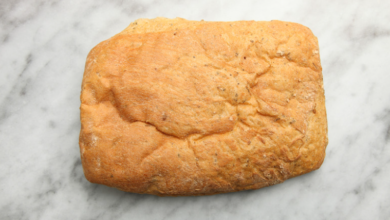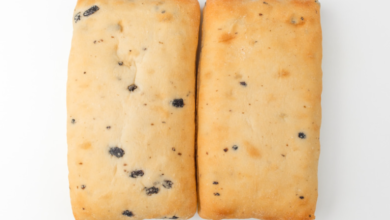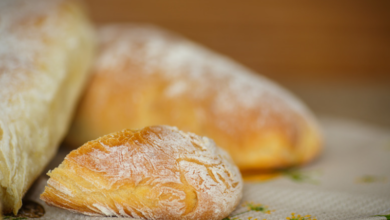Ciabatta Vs. Baguette: What’s the difference?

What To Know
- Bread, a staple food for centuries, comes in a myriad of forms, each with its unique flavor and texture.
- Ciabatta’s open crumb and mild flavor make it perfect for sandwiches and dipping, while baguette’s crusty exterior and wheaty flavor are ideal for classic French sandwiches and as a side for soups and stews.
- Whether you prefer the open crumb and mild flavor of ciabatta or the crisp crust and wheaty flavor of baguette, both breads offer a delightful way to elevate your culinary creations.
Bread, a staple food for centuries, comes in a myriad of forms, each with its unique flavor and texture. Two beloved varieties that stand out are ciabatta and baguette. Both hailing from different regions of Europe, these breads have become global favorites, gracing tables from casual gatherings to fine dining experiences. In this blog post, we delve into the fascinating world of ciabatta vs baguette, exploring their origins, characteristics, and culinary versatility.
Origins and History
Ciabatta
Ciabatta, originating from Northern Italy, is a relatively modern bread. Its name, meaning “slipper” in Italian, refers to its distinctive shape. Ciabatta was first created in the 1980s as an alternative to traditional Italian breads.
Baguette
Baguette, a symbol of French cuisine, has a much longer history. Its origins can be traced back to the 19th century in Paris. The term “baguette” means “stick” in French, aptly describing its elongated shape.
Characteristics and Texture
Ciabatta
Ciabatta is renowned for its large, open crumb structure, with irregular holes and a chewy, slightly crispy crust. Its dough is made from high-hydration flour, resulting in a moist and airy interior.
Baguette
Baguette, on the other hand, exhibits a dense, tight crumb and a crisp, golden-brown crust. Its dough is made from a lower hydration flour, giving it a firm and chewy texture.
Flavor Profiles
Ciabatta
Ciabatta has a mild, slightly sour flavor with hints of olive oil, which is often used in its preparation. Its open crumb allows it to absorb flavors well, making it ideal for pairing with dips, spreads, and fillings.
Baguette
Baguette possesses a more pronounced, wheaty flavor with a touch of sweetness. Its crusty exterior and dense crumb provide a satisfying crunch and a subtle nuttiness.
Culinary Versatility
Ciabatta
Ciabatta’s versatility shines in sandwiches, where its open crumb can accommodate a variety of fillings. It is also a popular choice for bruschetta, topped with tomatoes, garlic, and basil.
Baguette
Baguette is the quintessential bread for French sandwiches, such as the classic jambon-beurre (ham and butter). Its crusty exterior provides a satisfying crunch, while its dense crumb holds the fillings together.
Nutritional Value
Ciabatta
Ciabatta contains a moderate amount of fiber and protein. However, its high hydration makes it slightly lower in calories compared to other breads.
Baguette
Baguette has a similar nutritional profile to ciabatta, with a slightly higher fiber content. Its crusty exterior also contributes to a lower glycemic index, making it a more balanced choice for those monitoring their blood sugar levels.
Which Bread to Choose?
The choice between ciabatta and baguette ultimately depends on personal preference and the intended use. Ciabatta’s open crumb and mild flavor make it perfect for sandwiches and dipping, while baguette’s crusty exterior and wheaty flavor are ideal for classic French sandwiches and as a side for soups and stews.
Key Points: The Bread of Choice
Ciabatta and baguette, each with its unique characteristics and culinary versatility, have earned their place as beloved breads worldwide. Whether you prefer the open crumb and mild flavor of ciabatta or the crisp crust and wheaty flavor of baguette, both breads offer a delightful way to elevate your culinary creations.
What People Want to Know
Q: Is ciabatta healthier than baguette?
A: Both ciabatta and baguette have similar nutritional profiles, with ciabatta being slightly lower in calories due to its higher hydration.
Q: Can I substitute ciabatta for baguette in recipes?
A: While the two breads share some similarities, their different textures may affect the outcome of your recipe. For best results, use the bread specified in the recipe.
Q: How do I store ciabatta and baguette?
A: Store both breads in a cool, dry place. Ciabatta can be stored for up to 3 days, while baguette can last for up to 2 days.
Q: What are some creative ways to use ciabatta and baguette?
A: Ciabatta can be used for croutons, bread pudding, and stuffing. Baguette can be used for crostini, garlic bread, and panzanella salad.
Q: Can I make ciabatta and baguette at home?
A: Yes, both breads can be made at home with the right ingredients and techniques. However, they require some practice to achieve the desired results.




